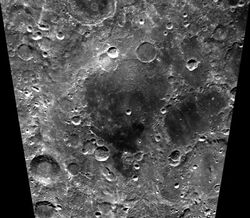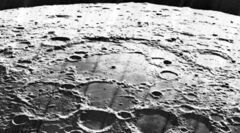Astronomy:Poincaré (crater)
 Clementine mosaic | |
| Diameter | 319 km |
|---|---|
| Depth | Unknown |
| Colongitude | 207° at sunrise |


Poincaré is a large lunar impact basin that lies in the southern hemisphere on the far side of the Moon. Most of the formation has been heavily eroded by subsequent impacts, leaving a battered formation with only rugged remnants of the original outer rim to the west.
The eastern half has been completely worn away, and much of the interior has been resurfaced by lava flows. This surface has a lower albedo than the surrounding terrain, giving it a dark appearance. A rugged formation forms a low north–south range across the eastern section of the floor, possibly the remnant of an inner ring.
The perimeter of Poincaré has several notable craters. To the north is the crater Hopmann, while the craters Abbe and Hess lie to the east. Directly to the west is Planck, a walled plain of similar dimensions to Poincaré. Both formations are sufficiently large to have formed a small lunar mare on the near side face of the Moon.
The basin's name was adopted in 1970 by the IAU.[1]
Satellite craters
By convention these features are identified on lunar maps by placing the letter on the side of the crater midpoint that is closest to Poincaré.
| Poincaré | Latitude | Longitude | Diameter |
|---|---|---|---|
| C | 54.4° S | 169.0° E | 20 km |
| E | 56.6° S | 171.1° E | 60 km |
| F | 57.9° S | 168.6° E | 95 km |
| J | 59.4° S | 168.7° E | 20 km |
| Q | 59.3° S | 160.9° E | 26 km |
| R | 60.2° S | 155.0° E | 52 km |
| X | 53.8° S | 161.9° E | 19 km |
| Z | 53.7° S | 164.9° E | 35 km |
References
- Wood, Chuck (November 21, 2006). "A Basin to Study". Lunar Photo of the Day. http://www.lpod.org/?m=20061121.
- Andersson, L. E.; Whitaker, E. A. (1982). NASA Catalogue of Lunar Nomenclature. NASA RP-1097.
- Blue, Jennifer (July 25, 2007). "Gazetteer of Planetary Nomenclature". USGS. http://planetarynames.wr.usgs.gov/.
- Bussey, B.; Spudis, P. (2004). The Clementine Atlas of the Moon. New York: Cambridge University Press. ISBN 978-0-521-81528-4.
- Cocks, Elijah E.; Cocks, Josiah C. (1995). Who's Who on the Moon: A Biographical Dictionary of Lunar Nomenclature. Tudor Publishers. ISBN 978-0-936389-27-1. https://archive.org/details/isbn_9780936389271.
- McDowell, Jonathan (July 15, 2007). "Lunar Nomenclature". Jonathan's Space Report. http://host.planet4589.org/astro/lunar/.
- Menzel, D. H.; Minnaert, M.; Levin, B.; Dollfus, A.; Bell, B. (1971). "Report on Lunar Nomenclature by the Working Group of Commission 17 of the IAU". Space Science Reviews 12 (2): 136–186. doi:10.1007/BF00171763. Bibcode: 1971SSRv...12..136M.
- Moore, Patrick (2001). On the Moon. Sterling Publishing Co. ISBN 978-0-304-35469-6. https://archive.org/details/patrickmooreonmo00patr.
- Price, Fred W. (1988). The Moon Observer's Handbook. Cambridge University Press. ISBN 978-0-521-33500-3.
- Rükl, Antonín (1990). Atlas of the Moon. Kalmbach Books. ISBN 978-0-913135-17-4.
- Webb, Rev. T. W. (1962). Celestial Objects for Common Telescopes (6th revised ed.). Dover. ISBN 978-0-486-20917-3. https://archive.org/details/celestialobjects00webb.
- Whitaker, Ewen A. (1999). Mapping and Naming the Moon. Cambridge University Press. ISBN 978-0-521-62248-6.
- Wlasuk, Peter T. (2000). Observing the Moon. Springer. ISBN 978-1-85233-193-1.
 |

